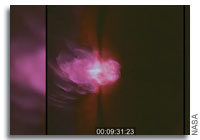Orion Astronaut View on Re-Entry
 Video: NASA Provides an Astronaut’s-Eye View of Orion’s Re-entry
Video: NASA Provides an Astronaut’s-Eye View of Orion’s Re-entry
“New video recorded during NASA’s Orion return through Earth’s atmosphere provides viewers a taste of what the vehicle endured as it returned through Earth’s atmosphere during its Dec. 5 flight test.”









Reaction Control jet plume interacting with the plasma trail is very cool effect!
Is this the first public video, ever, from the perspective of looking backwards, directly through the center wake of the plasma tail from an orbital reentry vehicle?? I mean, I know there is video from the Shuttle, but that is through the cockpit windows, and only shows some nice glow and occasional shock plasma. Here, we get to see very clear video, looking back through the wake, including thermal spectral changes up through peak heating and back down. We even get to see the spits and sparkles caused by ablation of the heat shield. Seriously, someone help me out here…I have never seen this captured on video before…specifically, a clear view/perspective looking directly back through the plasma channel. Is this a first?? Friggin’ amazing!!!!
there are some re-entry videos from the Gemini and Apollo capsules. example: http://youtu.be/1Gyn8Fx2Bfs
Very cool. Thanks Hug Doug. Serves me right. I should have lifted my fingers and did a little searching on YouTube before throwing out the question. Thanks, mate. In any case, the Orion HD (720p) video in absolutely beautiful and very detailed. The Gemini vid was very cool…but it didn’t have quite the brilliance and fireworks as Orion, which I assume has to do with the different re-entry speeds (Orion being approx 3,000 mph faster). I found an Apollo 14 reentry vid, and that was nice, but the camera angle and visual perspective through the capsule window wasn’t as ideal as this Orion vid…plus the video quality is poor (obviously).
Also, you might enjoy this paper that I came across, regarding a test of mitigating radio attenuation and alleviation of complete communication blackout during re-entry, by injecting water into the plasma sheath of the re-entry vehicle. This creates a narrow “window” in the plasma sheath which allows for radio frequency signals to pass through. Very interesting report. Test occurred on Gemini 3:
http://www.mrc.uidaho.edu/~…
More recent tests involve actively injecting metal-oxide ceramic powder material into the plasma sheath, or passively incorporating such material into the ablative heat shield.
Cheers,
John
no problem, John. feel free to call me Doug. Hug Doug feels so… formal lol.
I am the proud owner of a really neat collection of NASA documentary DVDs about the Gemini program so I knew about the reentry video from that.
I would also presume that the Orion video had a better camera than the one used on the Gemini missions, also 😛 might be able to capture a higher quality image and a larger dynamic range of color.
thanks for the link to the research study paper! it’s really amazing how much technical knowledge they had back then, and what they were able to accomplish with what nowadays we consider sticks-and-stones technology. papers like these present so much insight about hidden facets of the Mercury, Gemini, and Apollo missions. it’s stuff like this that makes me wonder in awe about how crazy it is to think that some people believe we never landed on the Moon!
Hi Doug, I couldn’t agree more with your final statement. Indeed, the moon hoax / conspiracy nutjobs are beyond my capability and capacity of understanding. It is almost like they have to actively work at being so blithely ignorant of facts and reality.
This is the camera view through the docking hatch window which is at the apex of the capsule, right on the centerline. Apollo didn’t have windows in that location and the shuttle windows in the rear were covered by the payload bay doors during entry. Here is more about the cameras from Ball Aerospace. http://www.ballaerospace.co…
They originally flew on STS-134 as part of a test of the Orion Automated Rendezvous and Docking subsystem. The heat shield is twice as large as Apollo so twice a many fireworks possible.
Hi David. Indeed, due to the amazing perspective, providing a near perfect view of the plasma wake/tail back to infinity-vanishing point…I was guessing that the imagery must be coming from a camera mounted somewhere near the apex of the capsule…but I wasn’t certain it was via a hatch/window directly in center-line beneath docking collar. Thanks for the info., as well as the link to the Ball Aerospace cameras. Good stuff!
I think would have been interesting to see the view via an IR camera. Maybe we’ll see as much someday. It was an interesting video, no matter what.
There are shuttle views thru the overhead windows looking back towards the wake.
Hmm.
I wonder if you can add certain minerals to the ablative shield to produce custom plasma colors.
Like fireworks.
In 2132 you’ll be choosing which color you want to re-enter to after your honeymoon moon trip.